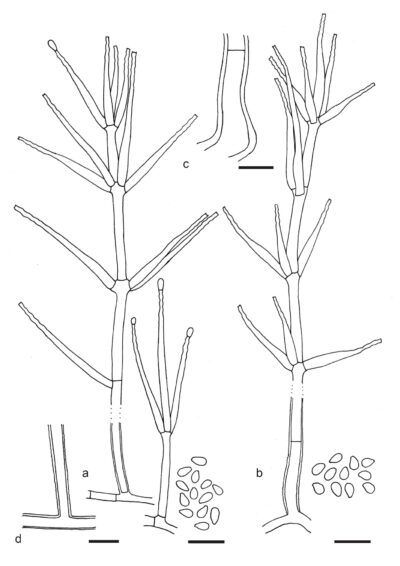Fungalpedia – Note 303, Ovicillium
Ovicillium Zare & W. Gams
Citation when using this entry: Perera et al. 2024 (in prep) – Fungalpedia, genera described in 2016.
Index Fungorum, Facesoffungi, MycoBank, GenBank, Fig. 1
Classification: Bionectriaceae, Hypocreales, Hypocreomycetidae, Sordariomycetes, Pezizomycotina, Ascomycota, Fungi
Based on LSU sequence data, Zare & Gams (2016) established Ovicillium to accommodate four species that produce white or whitish colonies and verticillium-like, erect conidiophores. Ovicillium species are mostly fungicolous hyphomycetes (Zare & Gams 2016). They produce strongly cyanophilic conidiophores that are up to 500 μm long and 4–7 μm wide near the base. Conidiophores are, smooth or rough walled near the base, frequently branched and mostly with secondary branches. Phialides are generally verticillate and arranged in 4–6 per whorl. They are 20–50 μm long, 1.5–2.5 μm wide near the base, and gradually tapering towards the apex. The phialide tip is undulated in some species. Conidia are generated in large globose heads. They are cyanophilic, subglobose, ovoid and napiform to cylindrical and have more or less apiculated bases. Globose to ovoid chlamydospores can be found in some species. Crystals are absent (Zare & Gams 2016). The sexual morph is undetermined. To date there are six species in the genus (Zare & Gams 2016; Hou et al. 2023).
Type species: Ovicillium attenuatum Zare & W. Gam
Other accepted species: Species Fungorum – search Ovicillium.
Figure 1 – Ovicillium attenuatum (a: CBS 112089; b: CBS 112090; c: CBS 158.96; d: CBS 399.86, ex-type). a, b Conidiophores and oval-attenuated conidia. c, d Rough surface of conidiophore bases. Scale bars: a–d = 10 μm. Redrawn from Zare & Gams (2016).
References
Entry by
Rekhani Hansika Perera, Center of Excellence in Fungal Research, Mae Fah Luang University, Chiang Rai, 57100, Thailand.
(Edited by Kevin D. Hyde, Samaneh Chaharmiri-Dokhaharani, & Achala R. Rathnayaka)
Published online 8 July 2024
